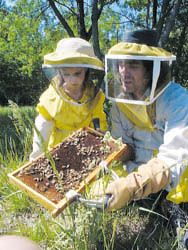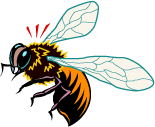Mmmmm … Lip-Smacking Honey

Spread it on your toast and lick it off your sticky fingers:
Honey is delicious.
A lot of hard work goes into a jar of honey. Thanks to Calvert County beekeepers Jeff Crespi and Kathy Stafford, junior reporter Mary Brewer got some hands-on experience finding out exactly how this sweet treat is made.
Busy as a Bee
This is especially true for bees between May and July. Honey bees collect pollen and nectar from the flowers around their hive. They store it inside their hive and use it for food. The nectar is stored inside a honeycomb made of wax that the bees also make. As days go by, some of the moisture in the nectar evaporates and it turns into honey, all ready for us to eat. Once we get it out of the hive.
Bees are called 'flower true'. This means that they will keep going back to the same flower every time they collect nectar. At Jeff and Kathy's farm, they like honey locust and tulip poplar flowers best. The type of flower the bee visits determines the color and taste of the honey. Bees that visit only orange blossoms or lavender flowers make honey that tastes like orange or lavender.
Busy as a Beekeeper
Jeff and Kathy have kept three bee hives on their farm for four years. Their business, C&S Honeypackers, got over 200 pounds of honey last year. It is a lot of work, and it takes some special equipment.
First, the beekeeper must be dressed so he or she doesn't get stung. This means being covered from head to toe in a bee suit, a hat with a net and big gloves. Mary was happy to put on the bright yellow outfit. She looked like a bee herself.
Next, with lots of bees buzzing around them, Jeff and Mary took off the top of the hive.
Before opening the hive, Jeff blew in smoke from a smoker. The bees think there is a fire and go deeper into the hive, eating as much honey as they can hold as they go. This makes them heavy and less likely to sting.
After the top was off the hive, Jeff pulled out the frames that contain the honeycomb and we could see what the bees have been up to. Small holes of wax were filled with the sweet golden honey.
Let's Eat
In July, Jeff and Kathy will collect the honey and put it in containers. Bees wax from the honeycomb can be used to make candles and furniture polish. The honey will then be ready to sell, give as gifts and, of course, eat!
Swarm:
 A Ball of Bees A Ball of Bees
Sometimes bees decide to leave their hive and form a swarm. This means that all the bees leave the hive together and surround the Queen bee to protect her. They will form a ball of bees on a tree branch with the queen bee in the middle. When Jeff and Kathy lost one of their hives because of disease, they caught a swarm to start a new hive.
Sound dangerous?
If you know what you’re doing, it really isn’t so dangerous. The bees are so busy thinking about the queen that they don’t want to sting. Jeff simply hit the ball with a stick, and the bees fell into a box that Kathy was bravely holding beneath the tree.
Bravo! An instant bee hive.
OUCH!
A bee sting hurts.
If you meet with the stinging end of a bee, wash off the area and put on a combo of
baking soda and water.
Hopefully, it will feel better soon.
Tired of Peanut Butter and Jelly?
Liven up your sandwich with HONEY.
- 2 slices of bread
- peanut butter
- apple slices
- honey
Spread a slice of bread with some peanut butter.
Top with apple slices and drizzle with honey.
Peanut Butter Sandwiches will never be the same.
The following words are hidden in the word search. Can you find them?
- hive
- pollen
- honey
- nectar
- beekeeper
- queen
- swarm
- sting
- wax
- comb
P O L L E N S V A S I
D P N E E U Q T A W H
L O Y S T I N G X A W
H B E E K E E P E R L
G M N R S K C C O M B
F W O U C T T X Y Z A
O E H I V E A B T D J
K N R G N H R A I L Q
|
Kids' Calendar
Budding Young Artists
Kids, brush off your art supplies and enter the Arts and Kids Art Competition. Everyone will enjoy an equal chance of winning the many prizes and scholarships. Beginners welcome. Deadline is July 31, 2000. Ages 17 and under.
Arts and Kids, 410/581-5900 www.ArtsandKids.com
Spring Music Making
Sat. May 20-Enjoy music all afternoon as kids from Music & Art Center present their Spring Recital. All Ages. Borders Cafe Espresso, Bowie: 301/352-5560.
Critters Under Your Feet
Sun. May 21 (1:00pm)-Snakes, earthworms, foxes and groundhogs are some of the creatures that live underground. Search for these burrowing dwellers. Ages 6-12. Kinder Farm Park, Millersville; rsvp: 410/222-6115.
The Great Flower Search
Tue. May 23 (10:30-12noon)-Explore woods and fields for the bright blooms of May. Then work on a craft and have a snack. Ages 3-5 with adult. Kings Landing Park, Huntingtown: 410/535-5327.
Excuse Me, What Did You Say?
Mon. May 22 (3-4pm)-Animals ‘talk’ to each other. Discover how animals communicate. Ages 8+. Patuxent Wildlife Refuge, Laurel; rsvp: 301/497-5887.
A ‘Beary’ Good Picnic
Tue. May 23. (12-1pm)-Pack a lunch and bring Mom and Dad along for a great picnic with a visit from a very special friend. Ages 3-5. Northeast Community Center, Chesapeake Beach. $3; rsvp: 410/257-2554.
Help Celebrate
Sun. May 21. (2-5pm)-Visit Chesapeake Children’s Museums Grand-Re-opening and make new discoveries about the area you live in. Free. Chesapeake Children’s Museum, Eastport Shopping Ctr, Eastport: 410/990-1993.
Copyright 2000
Bay Weekly
|